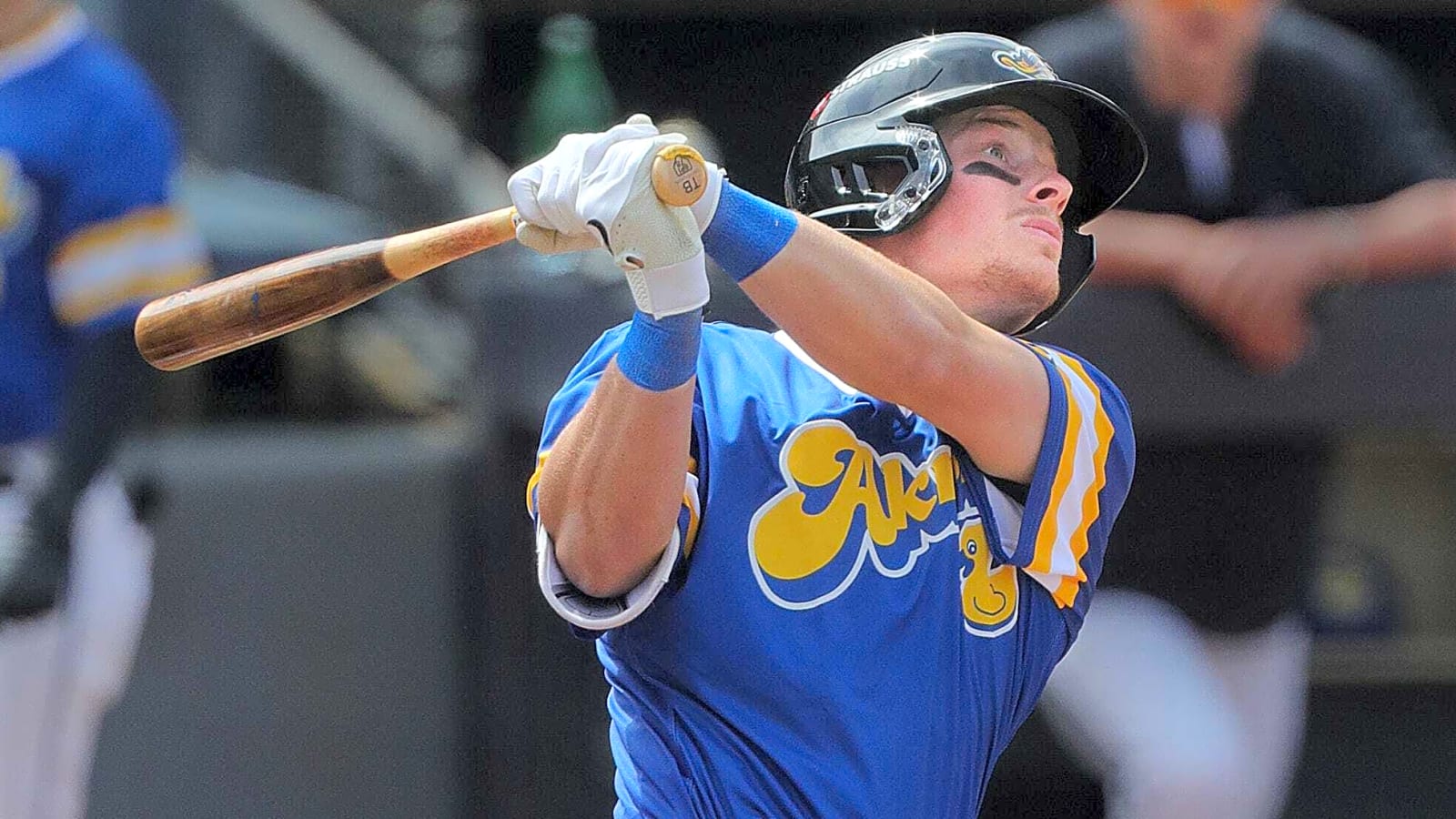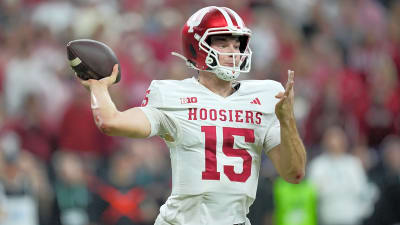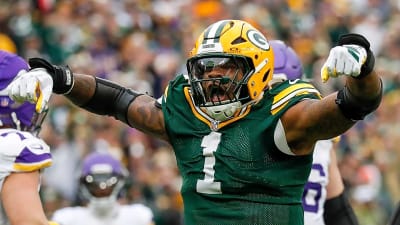
Back at the end of April, I wrote my first scouting notes story of the season, recapping some tremendous performances I saw in person over the first few weeks of the minor league season. Two weeks ago, I had the opportunity to take a look at another club’s farm team in person: the Cleveland Guardians.
I was also able to get a better look at some interesting prospects on the hometown Altoona Curve, something that’s always very interesting. The main player I saw during that week’s series, though, was last year’s number one overall pick, Travis Bazzana, who blew me away with his performance at the plate.
While the last few weeks featured a less impressive group of players overall, there are still plenty of performances to go over. So, let’s dive in.
Stats updated on May 21, 2025.
Akron RubberDucks
When taking a look at the Akron roster ahead of the series, the main name that stood out to me was Travis Bazzana. This was to be expected, given Bazzana’s pedigree as one of the best prospects in the game. However, I was pleasantly surprised by a few other names on the roster.
During past seasons, the RubberDucks have always produced an interesting team, with many of the Guardians’ top prospects taking the field for the team each year.
Also, it seems like the Guardians have a knack for producing similar players, as José Tena, Brayan Rocchio, and a few others have had similar styles of play throughout the years, leading me to expect similar things from their team this season.
I was also excited to get a look at Angel Genao, as he’s been a prospect I’ve been keeping a close eye on for a little while now. However, due to an injury, I wasn’t able to see Genao hit in person.
Aside from Bazzana, I was pleasantly surprised by one other prospect, 2B/OF Kahlil Watson. If the Guardians continue to excel at developing talent, they may have two very solid future major leaguers in Double-A.
Let’s break down each of these two prospects’ performances and what stood out to me last week.
Travis Bazzana, 2B
To put it simply, Travis Bazzana is arguably the one name I was looking forward to seeing the most this season. Getting a closer look at a former number one overall pick is always exciting, especially when the player possesses the tools Bazzana does.
The Guardians had a huge amount of faith in Bazzana when they selected him number one overall in last year’s draft, as they hope he’ll be a key piece of the team’s future. Following the draft, Bazzana signed with the Guardians for $8.95 million, the fourth-highest signing bonus in MLB history.
This was the first time I was able to see Bazzana, and he immediately made a huge impression on me. During his first at-bat of the series, he hit an impressive 110-mph exit velocity home run.
Bazzana just fell short of hitting the roller coaster in right field, something few hitters accomplish in Altoona. He also did this against a fastball in the high-90s, turning around some solid velocity for a long ball.
Travis Bazzana absolutely launched this 110 MPH nuke yesterday in his first at-bat. We’re just two games deep in this week’s series, but I’m blown away by the @CleGuardians top prospect. @JustBB_Media’s number 14 prospect pic.twitter.com/wjKNO2j4Cp
— Jay Staph (@jmstaph24) May 1, 2025
The sound the ball made when coming off his bat was also one of the loudest I’ve ever heard, which was a theme that repeated over the week. This home run sounded like a gunshot, which speaks to the power he possesses.
While I knew his power was an underrated piece of his game, I didn’t realize just how impressive it could be on the pull side. This level of power also isn’t typical, given his 6-foot-0, 199-pound frame.
This was the first of two impressive homers Bazzana hit during the week, but it was truly this first homer that made a lasting impression on me. From this point forward, Bazzana continued to attack Altoona pitching throughout the week, hitting nearly every ball in play extremely hard.
On the surface, Bazzana didn’t find many results at the plate. A lot of the hard contact he put in play went for lineouts or flyouts, which could be seen in his .200 BABIP. Even with this being the case, I was still very impressed by many of the batted balls I saw from Bazzana.
Bazzana did struggle with strikeouts and whiffs as well, which I found surprising. There were moments where it felt like he wasn’t getting much help from the umpires, but this is still something to note, regardless. He maintained a 30.8% strikeout rate during the week, as opposed to a 3.8% walk rate.
He was a better fielder and better runner than I expected as well, as these were both underrated aspects of his game. Despite considering him quite underrated in both of these aspects, I think he will undoubtedly need to remain at second base, as his range is not good enough for any other position.
Since leaving Altoona, Bazzana has continued to impress with his offensive abilities. In 149 plate appearances this season, he has hit four homers and slashed .252/.362/.433 with a 136 wRC+. Unfortunately, Bazzana injured his oblique, and he’s expected to miss 8-10 weeks.
Although, unfortunately, this injury will sideline Bazzana for a significant amount of time, it’s important to look to the positive takeaways I saw from him. Bazzana was everything I expected to see from a first overall pick, and I have no doubt he’ll be a very good big leaguer.
Kahlil Watson, SS/OF
Since he was selected back in the first round of the 2021 MLB Draft, Kahlil Watson has struggled to find his footing in professional baseball. He was dealt to the Cleveland Guardians after his stock fell due to an on-field incident with an umpire, and he’s currently in the midst of his second season in Double-A with the team.
I’ve seen Watson in person a few separate times, and I was always left puzzled at what scouts saw in him back in 2021. However, after seeing him this year with Akron, I can confidently say this is the best version of Watson I’ve seen thus far.
Previously, I always noticed holes in his swing, which led to a lot of strikeouts and an incomplete look at the plate. It always felt like something was missing. This time, Watson displayed a simplified approach, with a whippier barrel than I was used to seeing.
This resulted in a light-tower homer, which was likely the most impressive shot I’ve seen Watson hit in person. He handled velocity decently well while also staying selective in the box. He struck out just 14.3% of the time, which is one of the lower marks I’ve seen him post. He also walked 9.5% of the time, showing his discipline.
Similarly to Bazzana, his batted balls were almost always hit extremely hard, resulting in extremely loud contact. He hit two doubles in addition to his one homer, showing this pop shining through.
Watson was initially a shortstop when he first entered professional baseball, however, he’s recently been seen more in center field than any other position. He performed fairly well out there, as his speed allowed him to run down a few hard-hit fly balls I thought he had no chance to reach.
While it seems clear that Watson is no longer on the same track he was when he first entered professional baseball, there’s still a very good baseball player here in Watson when he’s at his peak. So far, he’s hit three homers and slashed .250/.330/.488 with a 134 wRC+ in 97 plate appearances.
Watson may be heading to Triple-A sooner rather than later, as the Cleveland Guardians continue searching for the skill set that made him such a highly touted prospect.
Altoona Curve
Now that we’ve covered the two prospects on the Akron RubberDucks that stood out to me, it’s time to dive into the hometown Altoona Curve and examine what their roster has to offer. This group of players is far different from the last time I wrote about the Curve’s roster, as much of this team has been shifted around.
In the last piece in which I covered the Curve, I explained how their roster followed the trend set by the Pittsburgh Pirates, where the pitching outweighed the offense. However, this time around, more offensive pieces stood out to me.
These players were third baseman Jack Brannigan, center fielder/second baseman Mitch Jebb, and righty Wilber Dotel. I truly believe all three of these players have flashed the tools to make an impact in the big leagues, and it’s just a matter of time until this comes to fruition.
Without further ado, let’s dive into these three players.
Disclaimer: Termarr Johnson has also impressed me more and more as the season has gone on, but I chose not to include him since I wrote about him in-depth in the last edition of this series.
Mitch Jebb, 2B/CF
When looking at the Pirates’ minor league system, it’s hard to find a hotter hitter right now than second baseman/center fielder Mitch Jebb. Jebb, a former second-round pick back in 2023, has looked more and more promising the longer he’s been in professional baseball.
Jebb was signed for $1.65 million. He is one of the few hitters the Pirates have taken a chance on early in the draft during the Cherington era. He’s known for his unorthodox swing and contact-oriented approach, both of which are equally unique features of his game.
Jebb’s swing has always been the one concerning area of his game for me, as he struggles to stay engaged in his lower half, often resulting in some rough swings. He tends to lean forward in his stride, almost like a softball player’s running swing.
However, this has not affected his game much at Double-A, as he’s toned down this move, making its failures less common than they were when he first entered the system. Jebb is one of the best contact hitters in the system, and that tool has been on full display this year.
Jebb’s ability to hit the ball perfectly where opposing defenders aren’t has allowed him to reach base consistently via base hits. He’s utilized all fields, having no problems finding holes in any opposing defense.
He’ll never be a significant power threat, as he homered just six times with the Greensboro Grasshoppers last season in Low-A. The Grasshoppers play in one of the most hitter-friendly ballparks in the lower minors, which helps put into perspective the limited power Jebb has to work with.
Yet, Jebb is a pretty tough out at the plate, as he has no problem fighting off pitches to work favorable counts. He’s only struck out 14% of the time so far this year, while walking just under 13.5% of the time.
He’s currently slashing .323/.417/.391 with a 138 wRC+. These numbers perfectly capture his hot start, and if this continues, Jebb could slowly climb prospect rankings during the season.
Jebb has shifted more to center field after entering professional baseball as a middle infielder, as the team has been prioritizing Termarr Johnson at second base. Jebb’s glove isn’t anything particularly special, yet he still makes the most of his reps in center field.
If he continues to develop, Jebb could become a very well-rounded player for the Pittsburgh Pirates.
Jack Brannigan, 3B/SS
As I previously mentioned, the Pittsburgh Pirates have struggled to develop offensive players during the Cherington era, which has significantly hurt the club’s current offensive structure. However, Jack Brannigan has been one of the few bright spots for the offense during this time.
After spending parts of two seasons in High-A, Brannigan has finally made his long-awaited debut in Double-A, and he’s been very impressive so far. A former third-round pick and Notre Dame alumnus, he has consistently shown some of the best pop in the Pirates’ minor league system, and he has continued to display this in Double-A.
Brannigan has phenomenal barrel control, allowing him to consistently hit the ball very hard. He usually utilizes this ability to the pull side, where he’s able to consistently pound the left field bleachers with home run balls.
So far this year, Brannigan has hit four long balls, which is second on the Altoona Curve’s roster. He routinely collects extra-base hits overall, as he’s also hit seven doubles and one triple so far this season.
While Brannigan has struggled occasionally to get his strikeouts under control, he excels at reaching base. He recently saw the conclusion of a 23-game hit streak, one of the longest in Curve history.
He’s currently slashing .238/.335/.385 with a 111 wRC+, an impressive set of numbers.
Brannigan is usually seen playing the hot corner, where he projects to be an above-average fielder. However, the Curve has utilized Brannigan at shortstop, an interesting choice considering his below-average range.
Regardless, Brannigan’s bat and consistent ability to make loud contact have led me to be very impressed with the 24-year-old, as I believe he could be one of the few hitters in the system who could make a legit impact on the big league team.
Wilber Dotel, SP
I mentioned in the introduction that not many arms stood out to me on the Curve’s roster, given the shakeup of the team. However, the lone arm that has really stood out is right-handed pitcher Wilber Dotel.
Ahead of this season, Dotel had barely gotten any recognition, as he often struggled to throw consistent innings at any level. For example, last season, Dotel pitched to a 5.33 ERA in 106.1 High-A innings, a less-than-stellar number. This season, though, the righty has been dominant.
Dotel has pitched 35.1 innings across eight Double-A starts, striking out a mind-blowing 30.7% of batters he’s faced, making him one of the better strikeout pitchers in Double-A. He’s also done this while maintaining an ERA in the low threes, showing his dominance.
Dotel throws an electric fastball that’s often been seen touching the high-90s, which he’s been able to use to his advantage. He’s often blown it past hitters, leaving them in shock. His slider has also been a good offering, creating a solid amount of deception when used correctly with his heater.
In an article by MLB.com’s Alex Stumpf, Dotel explains that his newfound splitter has really transformed his game, and I can certainly confirm this from watching his outings in person. It’s been a much better offering than his changeup, which used to be his tertiary pitch.
His splitter creates a dangerous tunnel with his fastball and slider, making it far harder for hitters to differentiate between the three pitches. It’s truly been one of the filthiest pitches in the Pirates’ minor league system, yet it keeps flying under the radar.
Dotel appears to be yet another example of the Pirates’ pitching lab, which has been developing new high-end arms practically every season over the last few years. If he continues to add to his arsenal and gets more experience against better hitters, he could be the next dominant pitcher in the system.
More must-reads:
- Athletics add another piece to impressive lineup with Jeff McNeil acquisition
- Mets' roster moves may have common thread
- The 'NFL's active 300-yard passers' quiz
Customize Your Newsletter
 +
+
Get the latest news and rumors, customized to your favorite sports and teams. Emailed daily. Always free!








